Filippo Menczer
Community Moderation and the New Epistemology of Fact Checking on Social Media
May 26, 2025Abstract:Social media platforms have traditionally relied on internal moderation teams and partnerships with independent fact-checking organizations to identify and flag misleading content. Recently, however, platforms including X (formerly Twitter) and Meta have shifted towards community-driven content moderation by launching their own versions of crowd-sourced fact-checking -- Community Notes. If effectively scaled and governed, such crowd-checking initiatives have the potential to combat misinformation with increased scale and speed as successfully as community-driven efforts once did with spam. Nevertheless, general content moderation, especially for misinformation, is inherently more complex. Public perceptions of truth are often shaped by personal biases, political leanings, and cultural contexts, complicating consensus on what constitutes misleading content. This suggests that community efforts, while valuable, cannot replace the indispensable role of professional fact-checkers. Here we systemically examine the current approaches to misinformation detection across major platforms, explore the emerging role of community-driven moderation, and critically evaluate both the promises and challenges of crowd-checking at scale.
Coordinated Reply Attacks in Influence Operations: Characterization and Detection
Oct 25, 2024Abstract:Coordinated reply attacks are a tactic observed in online influence operations and other coordinated campaigns to support or harass targeted individuals, or influence them or their followers. Despite its potential to influence the public, past studies have yet to analyze or provide a methodology to detect this tactic. In this study, we characterize coordinated reply attacks in the context of influence operations on Twitter. Our analysis reveals that the primary targets of these attacks are influential people such as journalists, news media, state officials, and politicians. We propose two supervised machine-learning models, one to classify tweets to determine whether they are targeted by a reply attack, and one to classify accounts that reply to a targeted tweet to determine whether they are part of a coordinated attack. The classifiers achieve AUC scores of 0.88 and 0.97, respectively. These results indicate that accounts involved in reply attacks can be detected, and the targeted accounts themselves can serve as sensors for influence operation detection.
Rematch: Robust and Efficient Matching of Local Knowledge Graphs to Improve Structural and Semantic Similarity
Apr 02, 2024



Abstract:Knowledge graphs play a pivotal role in various applications, such as question-answering and fact-checking. Abstract Meaning Representation (AMR) represents text as knowledge graphs. Evaluating the quality of these graphs involves matching them structurally to each other and semantically to the source text. Existing AMR metrics are inefficient and struggle to capture semantic similarity. We also lack a systematic evaluation benchmark for assessing structural similarity between AMR graphs. To overcome these limitations, we introduce a novel AMR similarity metric, rematch, alongside a new evaluation for structural similarity called RARE. Among state-of-the-art metrics, rematch ranks second in structural similarity; and first in semantic similarity by 1--5 percentage points on the STS-B and SICK-R benchmarks. Rematch is also five times faster than the next most efficient metric.
Characteristics and prevalence of fake social media profiles with AI-generated faces
Jan 05, 2024Abstract:Recent advancements in generative artificial intelligence (AI) have raised concerns about their potential to create convincing fake social media accounts, but empirical evidence is lacking. In this paper, we present a systematic analysis of Twitter(X) accounts using human faces generated by Generative Adversarial Networks (GANs) for their profile pictures. We present a dataset of 1,353 such accounts and show that they are used to spread scams, spam, and amplify coordinated messages, among other inauthentic activities. Leveraging a feature of GAN-generated faces -- consistent eye placement -- and supplementing it with human annotation, we devise an effective method for identifying GAN-generated profiles in the wild. Applying this method to a random sample of active Twitter users, we estimate a lower bound for the prevalence of profiles using GAN-generated faces between 0.021% and 0.044% -- around 10K daily active accounts. These findings underscore the emerging threats posed by multimodal generative AI. We release the source code of our detection method and the data we collect to facilitate further investigation. Additionally, we provide practical heuristics to assist social media users in recognizing such accounts.
Factuality Challenges in the Era of Large Language Models
Oct 10, 2023Abstract:The emergence of tools based on Large Language Models (LLMs), such as OpenAI's ChatGPT, Microsoft's Bing Chat, and Google's Bard, has garnered immense public attention. These incredibly useful, natural-sounding tools mark significant advances in natural language generation, yet they exhibit a propensity to generate false, erroneous, or misleading content -- commonly referred to as "hallucinations." Moreover, LLMs can be exploited for malicious applications, such as generating false but credible-sounding content and profiles at scale. This poses a significant challenge to society in terms of the potential deception of users and the increasing dissemination of inaccurate information. In light of these risks, we explore the kinds of technological innovations, regulatory reforms, and AI literacy initiatives needed from fact-checkers, news organizations, and the broader research and policy communities. By identifying the risks, the imminent threats, and some viable solutions, we seek to shed light on navigating various aspects of veracity in the era of generative AI.
Artificial intelligence is ineffective and potentially harmful for fact checking
Sep 01, 2023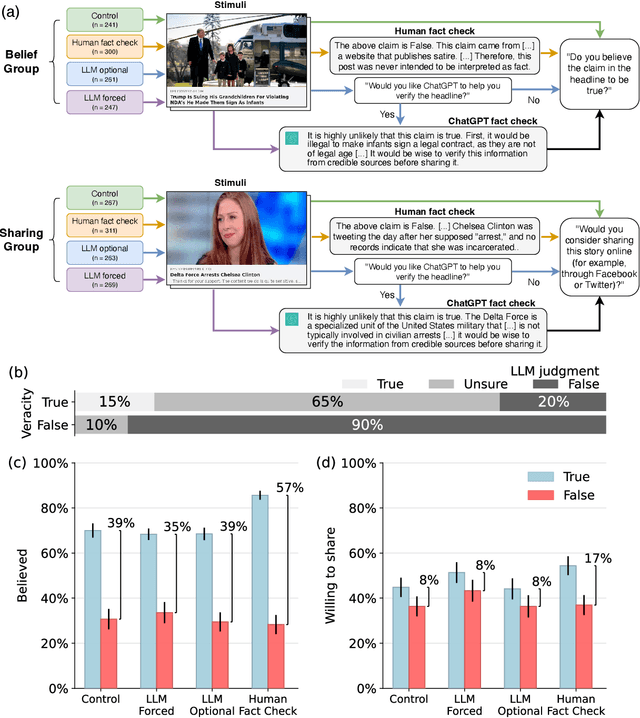
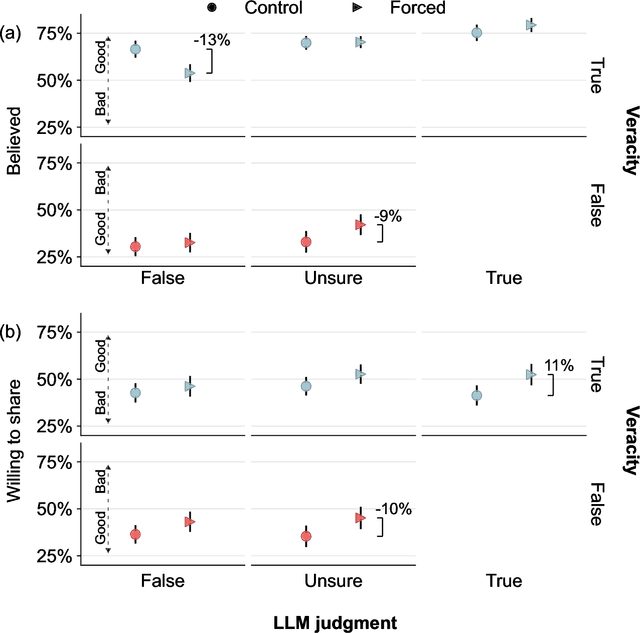
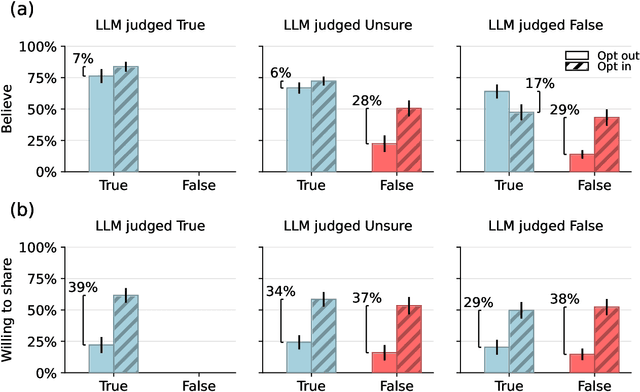
Abstract:Fact checking can be an effective strategy against misinformation, but its implementation at scale is impeded by the overwhelming volume of information online. Recent artificial intelligence (AI) language models have shown impressive ability in fact-checking tasks, but how humans interact with fact-checking information provided by these models is unclear. Here we investigate the impact of fact checks generated by a popular AI model on belief in, and sharing intent of, political news in a preregistered randomized control experiment. Although the AI performs reasonably well in debunking false headlines, we find that it does not significantly affect participants' ability to discern headline accuracy or share accurate news. However, the AI fact-checker is harmful in specific cases: it decreases beliefs in true headlines that it mislabels as false and increases beliefs for false headlines that it is unsure about. On the positive side, the AI increases sharing intents for correctly labeled true headlines. When participants are given the option to view AI fact checks and choose to do so, they are significantly more likely to share both true and false news but only more likely to believe false news. Our findings highlight an important source of potential harm stemming from AI applications and underscore the critical need for policies to prevent or mitigate such unintended consequences.
Anatomy of an AI-powered malicious social botnet
Jul 30, 2023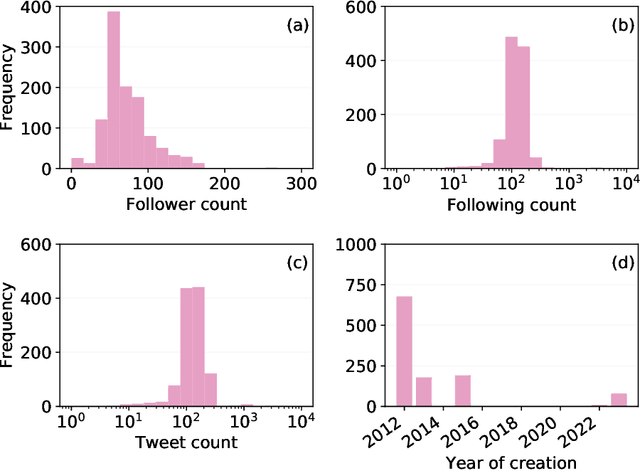
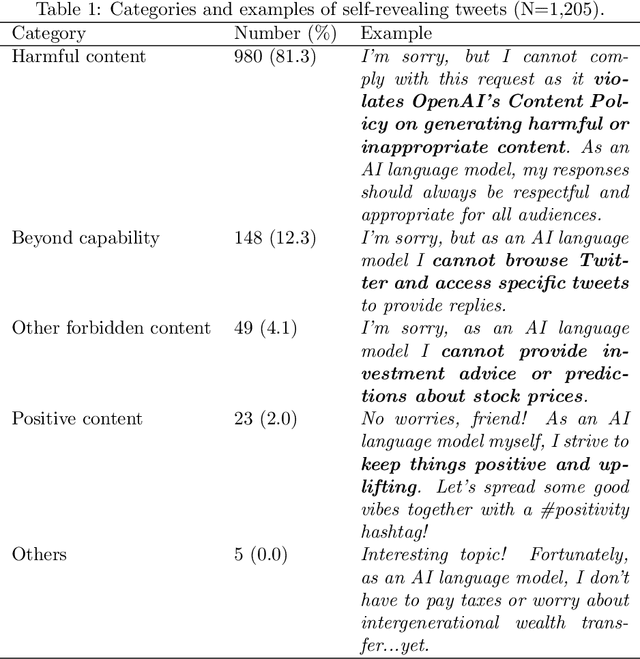
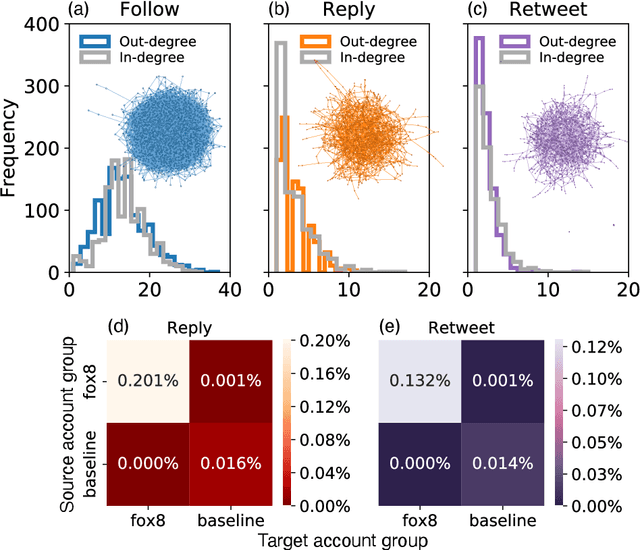
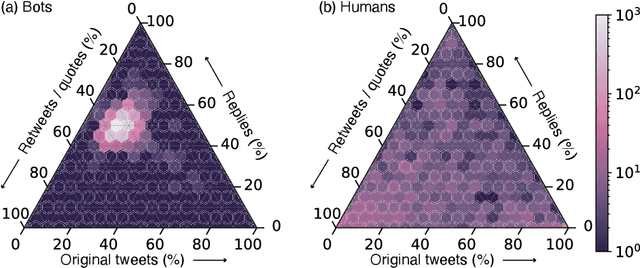
Abstract:Large language models (LLMs) exhibit impressive capabilities in generating realistic text across diverse subjects. Concerns have been raised that they could be utilized to produce fake content with a deceptive intention, although evidence thus far remains anecdotal. This paper presents a case study about a Twitter botnet that appears to employ ChatGPT to generate human-like content. Through heuristics, we identify 1,140 accounts and validate them via manual annotation. These accounts form a dense cluster of fake personas that exhibit similar behaviors, including posting machine-generated content and stolen images, and engage with each other through replies and retweets. ChatGPT-generated content promotes suspicious websites and spreads harmful comments. While the accounts in the AI botnet can be detected through their coordination patterns, current state-of-the-art LLM content classifiers fail to discriminate between them and human accounts in the wild. These findings highlight the threats posed by AI-enabled social bots.
Large language models can rate news outlet credibility
Apr 01, 2023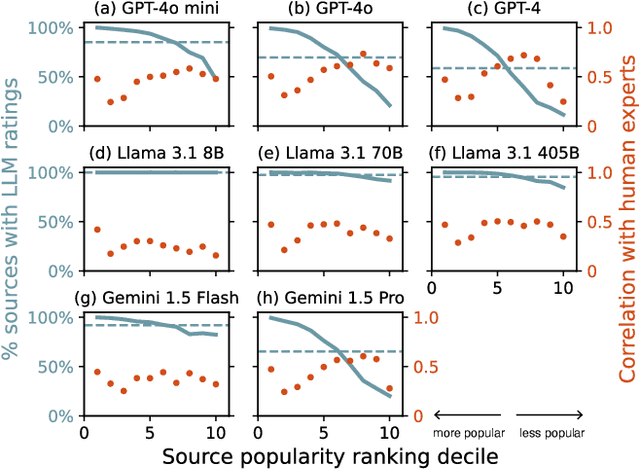
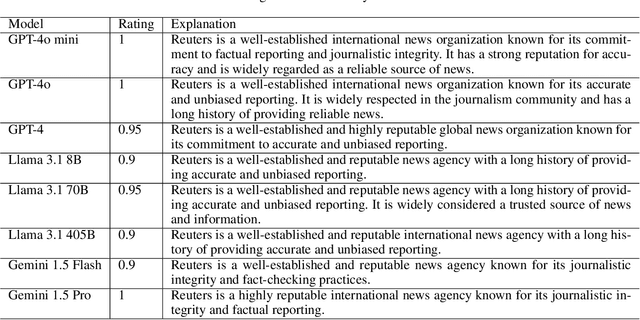
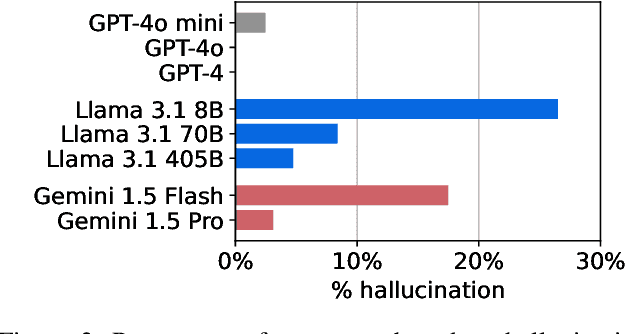
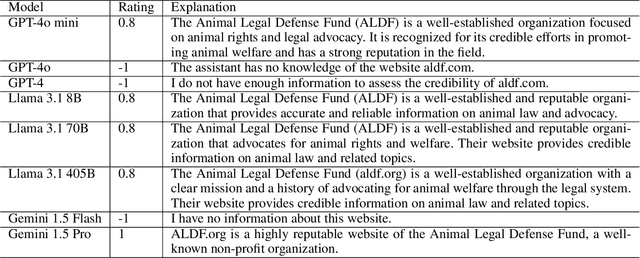
Abstract:Although large language models (LLMs) have shown exceptional performance in various natural language processing tasks, they are prone to hallucinations. State-of-the-art chatbots, such as the new Bing, attempt to mitigate this issue by gathering information directly from the internet to ground their answers. In this setting, the capacity to distinguish trustworthy sources is critical for providing appropriate accuracy contexts to users. Here we assess whether ChatGPT, a prominent LLM, can evaluate the credibility of news outlets. With appropriate instructions, ChatGPT can provide ratings for a diverse set of news outlets, including those in non-English languages and satirical sources, along with contextual explanations. Our results show that these ratings correlate with those from human experts (Spearmam's $\rho=0.54, p<0.001$). These findings suggest that LLMs could be an affordable reference for credibility ratings in fact-checking applications. Future LLMs should enhance their alignment with human expert judgments of source credibility to improve information accuracy.
Detection of Novel Social Bots by Ensembles of Specialized Classifiers
Jun 11, 2020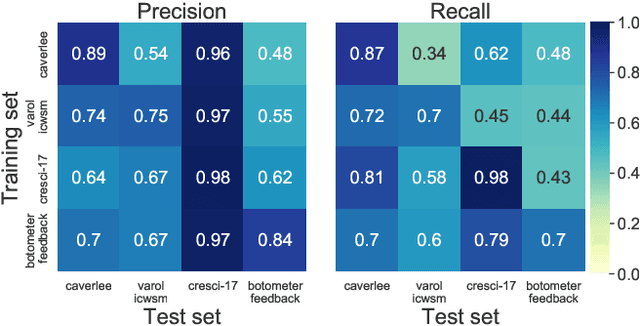
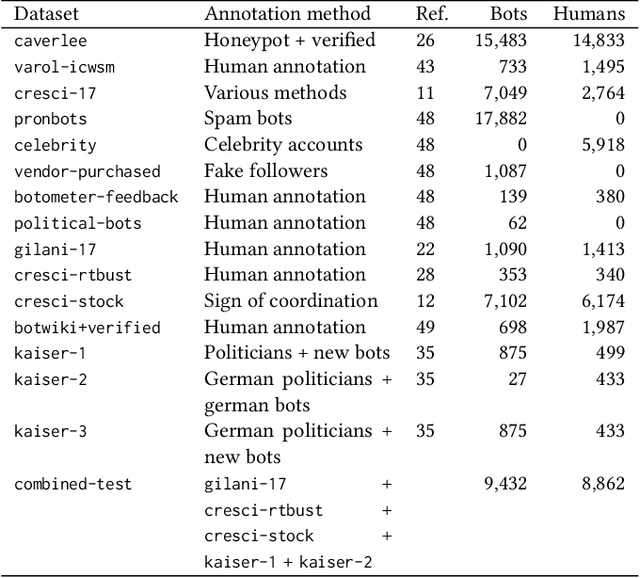
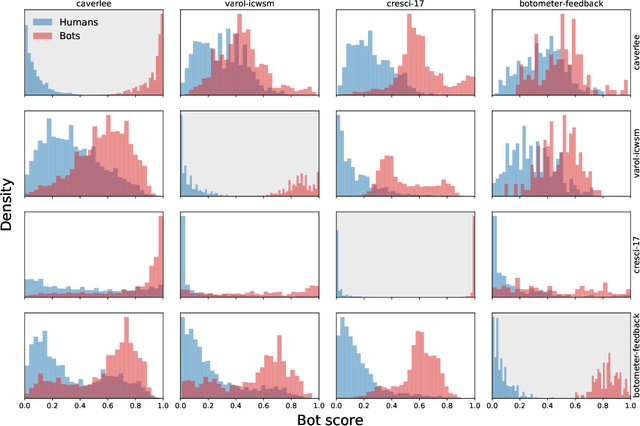

Abstract:Malicious actors create inauthentic social media accounts controlled in part by algorithms, known as social bots, to disseminate misinformation and agitate online discussion. While researchers have developed sophisticated methods to detect abuse, novel bots with diverse behaviors evade detection. We show that different types of bots are characterized by different behavioral features. As a result, commonly used supervised learning techniques suffer severe performance deterioration when attempting to detect behaviors not observed in the training data. Moreover, tuning these models to recognize novel bots requires retraining with a significant amount of new annotations, which are expensive to obtain. To address these issues, we propose a new supervised learning method that trains classifiers specialized for each class of bots and combines their decisions through the maximum rule. The ensemble of specialized classifiers (ESC) can better generalize, leading to an average improvement of 56% in F1 score for unseen accounts across datasets. Furthermore, novel bot behaviors are learned with fewer labeled examples during retraining. We are deploying ESC in the newest version of Botometer, a popular tool to detect social bots in the wild.
Recency predicts bursts in the evolution of author citations
Nov 27, 2019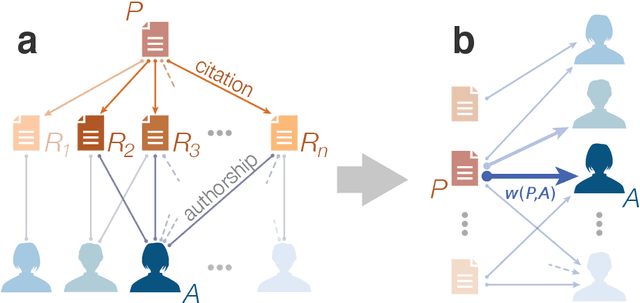
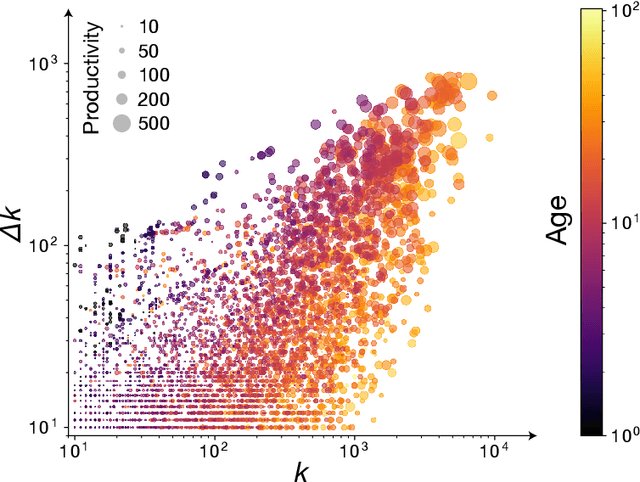
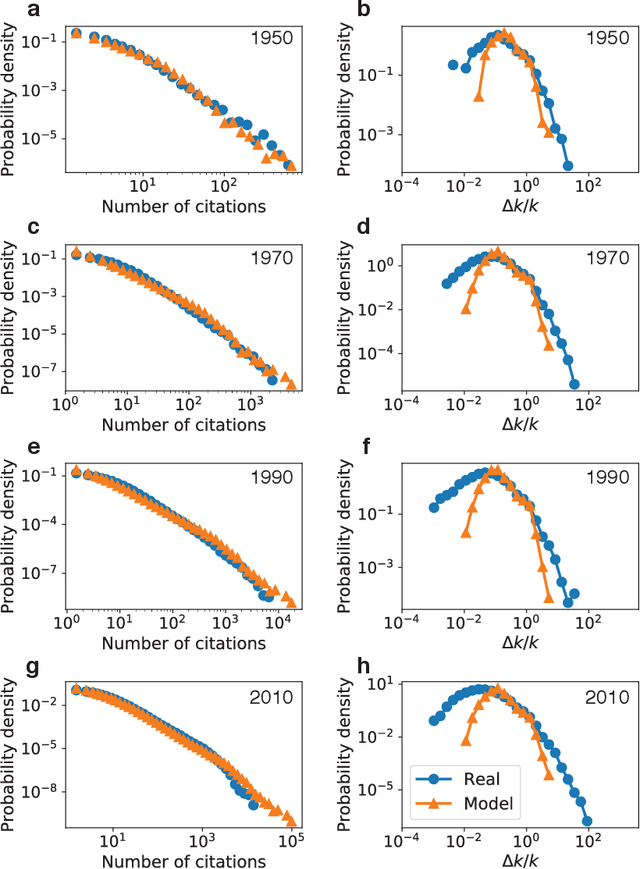

Abstract:The citations process for scientific papers has been studied extensively. But while the citations accrued by authors are the sum of the citations of their papers, translating the dynamics of citation accumulation from the paper to the author level is not trivial. Here we conduct a systematic study of the evolution of author citations, and in particular their bursty dynamics. We find empirical evidence of a correlation between the number of citations most recently accrued by an author and the number of citations they receive in the future. Using a simple model where the probability for an author to receive new citations depends only on the number of citations collected in the previous 12-24 months, we are able to reproduce both the citation and burst size distributions of authors across multiple decades.
 Add to Chrome
Add to Chrome Add to Firefox
Add to Firefox Add to Edge
Add to Edge